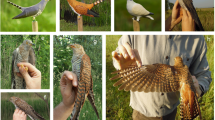Abstract
The relationship between colouration and kleptoparasitic efficiency (success rate and chase rate) was studied in the polymorphic arctic skua, Stercorarius parasiticus, at a Mediterranean migration site. A shift in the ratio of morphs through the spring, presumably caused by differential migration between populations that differ in morph frequency (the higher the latitude, the more frequent is the pale morph), allowed the comparison of the relative performances of pale and dark birds under different scenarios of morph frequency. Chase rate showed a clear frequency-dependent effect in chases by solitary skuas, birds of the rare morph always conducting more chases than expected. This trend was explained by chases of yellow-legged gulls, Larus michahellis, a relatively large and aggressive species that was difficult to chase (i.e. chases resulted in low success rate) but provided potentially higher reward (i.e. more food) than any other host. These differences could result from the perceived cost-benefit balance of chases, as skuas from the rare morph could find an advantage in chasing this host species by being less rapidly recognised. This is in agreement with the apostatic selection hypothesis, which says that the rare morph in a predator or parasite population is favoured through its unfamiliarity to potential prey or hosts (the surprise effect). Differences in success rate could have provided further support to this interpretation, but sample size was not sufficient for a proper comparison at the host-species level.

Similar content being viewed by others
References
Allen JA, Raison HE, Weale ME (1998) The influence of density on frequency-dependent selection by wild birds feeding on artificial prey. Proc R Soc Lond B 265:1031–1035
Andersson M (1976) Predation and kleptoparasitism by skuas in a Shetland seabird colony. Ibis 118:208–217
Arcos JM (2000) Host selection by arctic skuas Stercorarias parasiticus in the North-western Mediterranean during spring migration. Ornis Fenn 77:131–135
Arnason E (1978) Apostatic selection and kleptoparasitism in the parasitic jaeger. Auk 95:377–381
Bélisle M (1998) Foraging group size: models and a test with jaegers kleptoparasitizing terns. Ecology 79:1922–1938
Bond AB, Kamil AC (1998) Apostatic selection by blue jays produces balanced polymorphism in virtual prey. Nature 395:594–596
Caldow RWG, Furness RW (1991) The relationship between kleptoparasitism and plumage polymorphism in the Arctic Skua Stercorarius parasiticus (L). Funct Ecol 5:331–339
Fowlie MK, Kruger O (2003) The evolution of plumage polymorphism in birds of prey and owls: the apostatic selection hypothesis revisited. J Evol Biol 16:577–583
Furness BL, Furness RW (1980) Apostatic selection and kleptoparasitism in the parasitic Jaeger: a comment. Auk 97:832–836
Furness RW (1978) Kleptoparasitism by great skuas (Catharacta skua Brünn.) and arctic skuas (Stercorarius parasiticus L.) at a Shetland seabird colony. Anim Behav 26:1167–1177
Furness RW (1987) The skuas. Poyser, London
Galeotti P, Rubolini D, Dunn PO, Fasola M (2003) Colour polymorphism in birds: causes and functions. J Evol Biol 16:635–646
Jones T (2002) Plumage polymorphism and kleptoparasitism in the arctic skua Stercorarius parasiticus. Atl Seabirds 4:41–52
Palleroni A, Miller CT, Hauser M, Marlet P (2005) Prey plumage adaptation against falcon attack. Nature 434:973–974
Paulson DR (1973) Predator polymorphism and apostatic selection. Evolution 27:269–277
Payne RB (1967) Interspecific communication signals in parasitic birds. Am Nat 101:363–375
Raymond DL, Allen JA (1990) Wild birds prefer the familiar colour pattern when feeding on similar artificial morphs. Oikos 57:175–179
Rohwer S (1983) Formalizing the avoidance-image hypothesis: critique of an earlier prediction. Auk 100:971–974
Roulin A, Wink M (2004) Predator-prey relationships and the evolution of colour polymorphism: a comparative analysis in diurnal raptors. Biol J Linn Soc 81:565–578
Shigemiya Y (2004) Reversible frequency-dependent predation of a puffer, Takifugu niphobles (Pisces : Tetraodontidae), related to spatial distribution of colour-polymorphic prey. Biol J Linn Soc 81:197–202
Wunderle JMJr (1991) Age-specific foraging proficiency in birds. Curr Ornithol 8:273–324
Zar J (1996) Biostatistical analysis. Prentice Hall, London
Acknowledgments
I am most grateful to Ana de León, Antonio Hernández-Matías, Sin Yeon Kim, Raimon Mariné, Alejandro Martínez-Abraín, Eduardo Mínguez, Daniel Oro, Cristina Sánchez-Alonso, Daniel Sol, Giaccomo Tavecchia, Alberto Velando, Steve Votier, two anonymous referees and the editor, for their helpful comments and criticisms to this manuscript. This study was partially supported by a Marie Curie individual fellowship (ref. QLRT-2000-00839). The study complies with the current laws of Spain.
Author information
Authors and Affiliations
Corresponding author
Rights and permissions
About this article
Cite this article
Arcos, J.M. Frequency-dependent morph differences in kleptoparasitic chase rate in the polymorphic arctic skua Stercorarius parasiticus . J Ornithol 148, 167–171 (2007). https://doi.org/10.1007/s10336-006-0114-0
Published:
Issue Date:
DOI: https://doi.org/10.1007/s10336-006-0114-0




